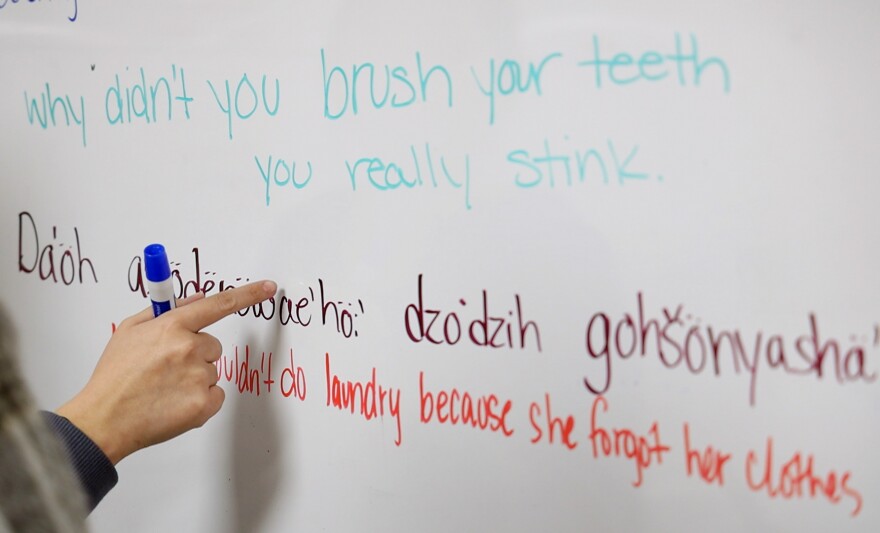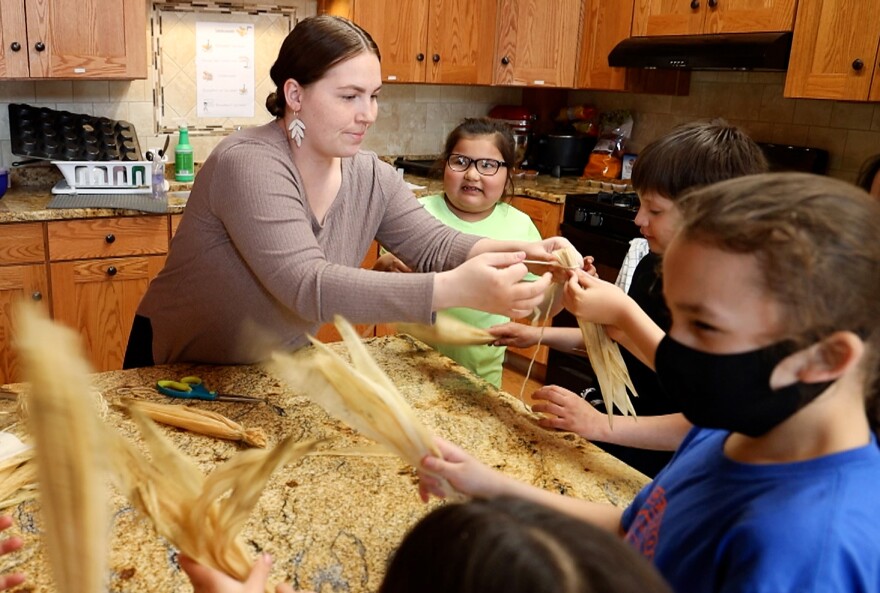Noelle Evans won a national Edward R. Murrow award in the category of Excellence in Diversity, Equity and Inclusion for this story.
A few days a week, the Tonawanda Seneca Nation office transforms into a bustling language school.
Jayden Parker, 22, is one of the advanced Seneca language students at Honöta:önih Hënödeyësdahgwa'. He was inspired by a strong desire for connection and understanding.
“I grew up with a lot of older people, so they all spoke the language,” Parker said. “I wanted to be able to speak with them, too, and understand what they're saying. And then have them understand me as well.”
The classes range from kindergarten through adult classes, like the one Parker is taking, which involves transcribing recordings of Native speakers and learning ceremonial speeches.
“This is my home. And this is where I thrive. There's no other place that I could really see myself being,” Parker said. “I just hope to bring the language back as much as we can ... just to be helping my people as much as I can.”
For about 100 years, some Seneca people have worked to revitalize their language, which was largely eradicated as generations of Native American children were forced to attend more than 400 boarding schools that operated in the 19th and 20th centuries.
That work led to the creation of this language program in Tonawanda in western New York about 20 years ago. Adult classes, where students are paid a stipend to learn, were added to the program six years ago.
Today, Parker is reciting the words of a springtime ceremony to give thanks to the maple trees.
“It's the language that in our belief that our Creator gave to us,” Parker said. “So it does come with a feeling of pride to be able to speak that language that our that our elders and our ancestors spoke before us.”
This is a matter of life and death for the Seneca language and every aspect of the culture and traditions linked to it.
The language is at risk of extinction. According to the Endangered Languages Project, there are fewer than 50 Native Seneca speakers worldwide.
Who will speak at my funeral?
One of the school’s major influences is the late Chief Corbett Sundown, who led the Tonawanda Seneca community from the 1930s until the early 1990s. Many of Sundown’s speeches were recorded, and today, those recordings and their transcripts are resources for classes.
Sundown, a longhouse ceremonial orator, was one of the last fluent speakers of Seneca. He worked with linguist Wallace Chafe to preserve the language, which was controversial at the time, according to Seneca teacher Wayne Abrams.
“He kind of got criticized for working with that linguist,” Abrams said. “Because of what he does to our language. He really breaks it apart and applies rules to it. And that kind of takes away from, you know, the specialness of the language.”
One of Sundown’s reasons was personal.
“He says that he's recording all these things because what he thinks is that when he dies, there's going to be no one to speak at his funeral,” Abrams said.

Without the Seneca language, funeral rites could go missing. Wedding ceremonies could be lost. Some ceremonies have already disappeared.
Abrams said they’d rather not perform a ceremony at all than perform it in English. Some things just don’t translate.
The Seneca language is not alone in its precarious status. According to the online language encyclopedia Ethnologue, there are 164 dying languages in the U.S. alone.
Experts with the Indigenous Language Institute say there used to be more than 300 Indigenous languages here.
‘òewagë´ nigöhga:nyeh,’ — 'It bites on my mind’
Jamie Jacobs used to be the language school director at Tonawanda. Now he is the curator of Seneca artifacts with the Rock Foundation at the Rochester Museum & Science Center.
Seneca is complex, but to put it simply, Jacobs said there are two distinct ways of speaking: conversationally and philosophically. Take the word for “home,” for instance:
“We can just say, ‘aknöhsod,’ which just means ‘my standing house, my home,’ but we have a way more complex way of saying ‘my home,’ and we say ‘òewagë´ nigöhga:nyeh,’
Literally, that means: “It bites on my mind.”
“So I guess that refers to the effect of being homesick or being away from home and something just pulling you back home,” Jacobs said. “But literally, that's what it means.”
Seneca is also a polymorphic language, meaning one word can end up encapsulating an entire phrase or complete sentence.
“To speak and understand Seneca and hear it, you actually have to think twice as fast because when somebody speaks one sentence in Seneca, they're actually speaking probably half a paragraph,” he said.

Learning the intricacies of the language has been reshaping Jacobs’ worldview since the early 2000s. It was how he and his great-grandmother used to connect.
Sometimes she would translate musical recordings for him, including songs performed by his great-great-grandfather, Chief Edward Black of the Hawk Clan. He served as ceremonial custodian, singer and orator for the Tonawanda Seneca community for many years, Jacobs said.
But there are at least two generations in his family who do not speak Seneca.
It’s partly a result of the boarding schools that Native American children were forced to attend from the 1800s through the late 1970s. There, students were abused, and beaten for speaking their Native language. Their hair was cut. Their identities — largely erased.
“I do remember my great-grandmother telling stories, because her brothers and sisters were sent to boarding school. They were sent to the Thomas Indian School in Cattaraugus,” Jacobs said. “So that cut off this holistic way of handing down language, whereas now I have to learn it as a second language.”
Reconnecting to his heritage through the language has led to unearthing moments in history that are in a way still alive today through those very words.
“There's words for things we have that our ancestors didn't have 200 years ago,” he said. “So we didn't have coins. But we have a word for a coin: o:wi:sda’.”
O:wi:sda’ means fish scale.
“Our ancestors had to descale fish, and they use fish skin for different things. So that's history,” Jacobs said. “So now when I say the word, o:wi:sda’, I don't just picture a silver coin. I picture my ancestors, descaling fish, and I picture them doing all these things. And that gives me a lot of pride.”
Seneca is a dynamic language. It keeps evolving just as the Seneca people have.
And for Jacobs, with every new word he learns, there is a deepening sense of connection. to himself, to his community, his ancestors. There’s continuity with a way of life that was taken away from him and others.
And perhaps there’s a greater sense of belonging. Knowing you have a place in the world, in the universe.
And that’s something that can be shared with anyone, people who live on the same land that has been the home of Seneca traditions, and those farther away.
“I think that if more people just understood our language, even just have a general sense of how it works and how we think, well, then I think more people would be more open and fascinated to learn about who we are.”

Noelle Evans won a national Edward R. Murrow award in the category of Excellence in Diversity, Equity and Inclusion for this story.




